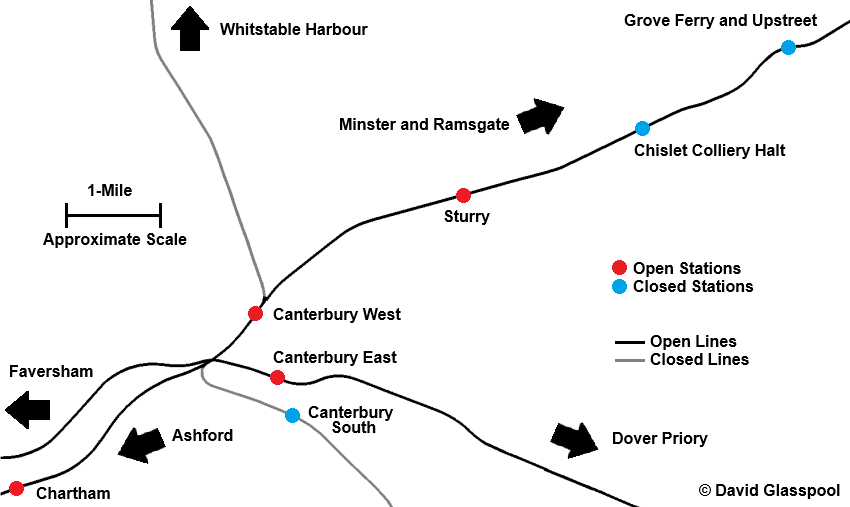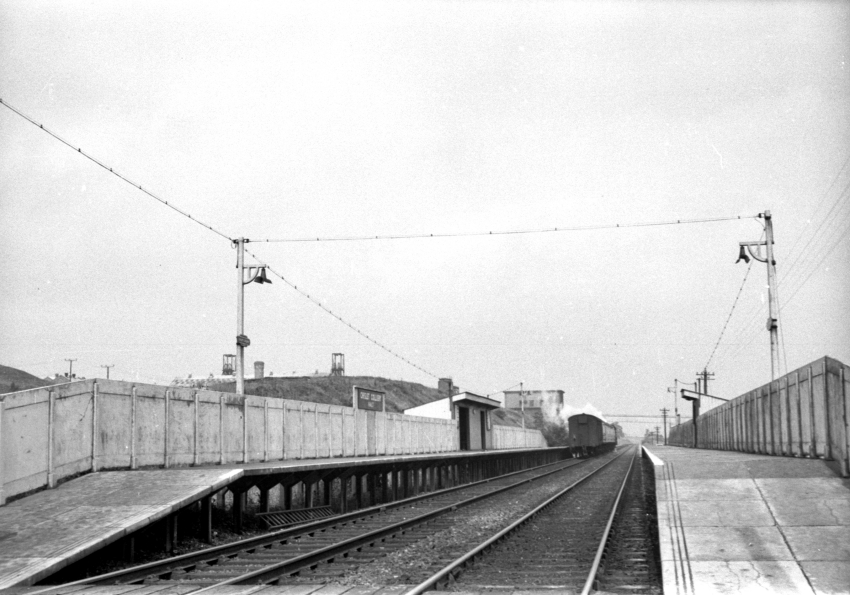Chislet Colliery Halt
In the Whitstable and Tankerton Times on 14th February 1914, it was reported that a general commencement of operations would take place over the following few weeks in connection with a proposed Chislet Colliery. The 18th April 1914 edition of the same publication reported that these operations were proceeding apace at Westbere Court — in-between Westbere (Sturry, Canterbury) and Grove Ferry — where a railway siding was being formed and boring taking place, the latter to ascertain the nature of the strata prior to shafts being sunk in the area. The boring equipment had arrived on site on 3rd April 1914 (ref: The Colliery Guardian and Journal of the Coal and Iron Trades, 20th February 1920). The siding was to link the colliery with the South Eastern & Chatham Railway (SE&CR) and was laid by contractor Mr George Browning of St George’s Place, Canterbury (ref: The Faversham Mercury, 9th May 1914).
By mid-June, the test boring at Westbere Court had been completed, preparations were being made to sink the shafts, and the light railway linking the site with the SE&CR's line near Grove Ferry station was virtually complete (ref: The Whitstable Times and Tankerton Press, 13th June 1914). Two pits were completed at the site: North Pit and South Pit. Coal started to be wound from the former in August 1918; however, by February 1920, coal had still not been wound from South Pit (ref: The Colliery Guardian and Journal of the Coal and Iron Trades, 20th February 1920).
Now onto the station. In the 6th September 1919 edition of the London Evening News, it was reported that the SE&CR was proposing to erect a station near Chislet Colliery. Whilst your author has been unable to pin down an exact date of opening, the halt is marked on a plan of the site published in February 1920 (ref: The Colliery Guardian and Journal of the Coal and Iron Trades, 20th February 1920), suggesting that it was open by that time. Two platforms of timber construction were brought into use, situated south west of the colliery, each of which had a waiting shelter midway down their length. Sturry, Chislet Colliery Halt, and Grove Ferry came under the same Station Master, who until 1936 was Mr Ernest C. Hopkins — he had started at Grove Ferry in 1916 (ref: Herne Bay Press, 24th April 1943).
The Summer Service of 1926 had six departures in the Ashford direction calling at Chislet Colliery Halt, Monday to Saturday: 9:05 AM, 11:48 AM, 2:31 PM, 4:26 PM, 9:18 PM, and 10:31 PM; on Sundays, departures were at 6:49 AM and 11:17 PM (ref: The Thanet Advertiser, 7th August 1926). In the Margate direction, Monday to Saturday, departures were at 7:41 AM, 11:37 AM (Not Saturdays), 11:51 AM (Saturdays only), 1:22 PM, 3:14 PM, 3:18 PM, 5:34 PM, 8:22 PM, and 10:29 PM; on Sundays, departures were at 10:26 AM, 12:21 PM, and 10:14 PM (ref: The Thanet Advertiser, 7th August 1926).
In connection with the Kent Coast Electrification Scheme, the platforms at Chislet Colliery Halt were rebuilt in prefabricated concrete (ref: Southern Electric 1909-1979, G.T. Moody). On 27th May 1962, a then new brick-built signal box was opened about 750-yards north east of the halt, to control revised connections with the colliery (ref: Volume 4, Southern Railway Register Section B13: Ashford to Ramsgate Town, Signalling Record Society).
The station became Chislet Colliery on the start of the summer timetable of 1969, effective 5th May of that year — on and from that date, the suffix halt was discontinued by British Rail network-wide (ref: RCTS' The Railway Observer, June 1969). Thursday, 24th July 1969 was the last day of operation at the colliery, closure being enacted by the National Coal Board (ref: East Kent Times, 25th July 1969); however, the station remained open. Closure of Chislet Colliery station to passenger traffic was effective on and from 4th October 1971 (ref: RCTS’ The Railway Observer, December 1971 and The Railway Magazine, November 1971), but the platforms remained in use for railway staff (ref: Railways of the Southern Region, Geoffrey Body, 1984). The signal box of 1962 ceased to be used on 23rd July 1984 and was permanently closed on 14th September 1986 (ref: Volume 4, Southern Railway Register Section B13: Ashford to Ramsgate Town, Signalling Record Society).

20th June 1958

Once located 75-miles 16-chains from Charing Cross via Orpington and Tonbridge, a Ramsgate-bound view shows the then recently rebuilt halt. Works had not quite finished — it appears that the lamps had yet to receive bulbs and there is a ladder down at track level. Whilst the platforms were concrete, the waiting shelters were of timber construction — based on photographs, they dated from the original halt. The waiting shelter on the Ramsgate-bound platform was about 50-feet in length, its Canterbury-bound counterpart being only about 10-feet-long. In the left background is the halt’s namesake, to which a trailing connection was made from the Ramsgate-bound track ⅔-mile north east of the platforms. As far as your author is aware, the halt's platforms still exist today, but the waiting shelters are long gone. © David Glasspool Collection
Return to the Kent Rail Homepage or alternatively, check for Updates.
Website & Copyright information - Links - Contact the Webmaster
